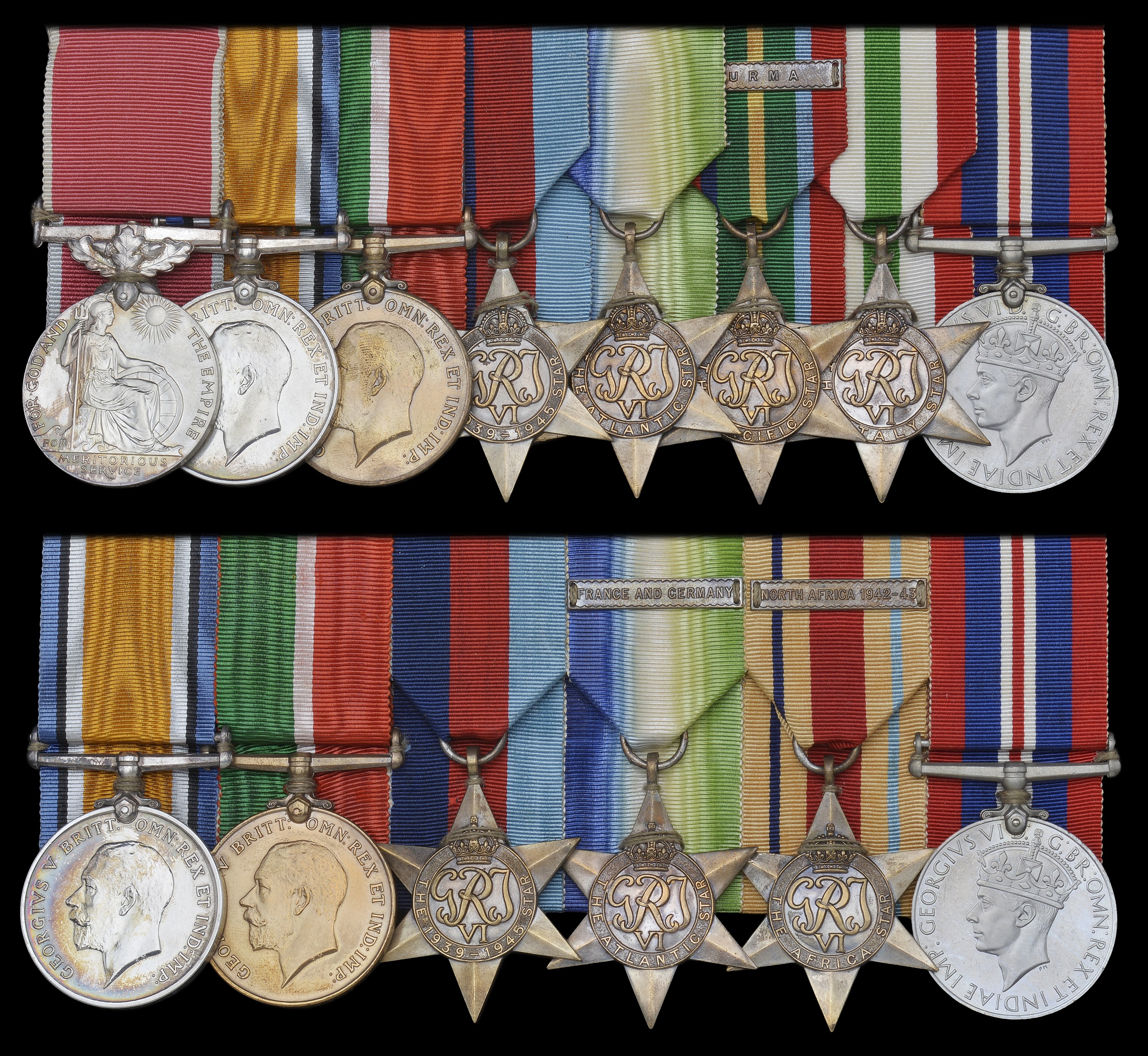Family Group: A Second War B.E.M. group of eight awarded to Chief Steward G. Watkins, Mercantile Marine, who survived a week in an open boat after the M.V. Trevilley was torpedoed and sunk in the South Atlantic in September 1942 British Empire Medal, (Civil) G.VI.R., 1st issue (George Watkins); British War and Mercantile Marine War Medals 1914-18 (George Watkins); 1939-45 Star; Atlantic Star; Pacific Star, 1 clasp, Burma; Italy Star; War Medal 1939-45, mounted court-style for display, nearly extremely fine Six: Donkeyman W. E. Watkins, Mercantile Marine, who survived the loss of both the S.S. Nalon when she was bombed and sunk by a FW 200 Condor off Ireland in May 1940, and the S.S. Nicoya when she was torpedoed and sunk in the Atlantic in May 1942 British War and Mercantile Marine War Medals 1914-18 (William E. Watkins); 1939-45 Star; Atlantic Star, 1 clasp, France and Germany; Africa Star, 1 clasp, North Africa 1942-43; War Medal 1939-45, mounted court-style for display, minor spot of verdigris to MMWM, nearly extremely fine (14) £500-£700 --- B.E.M. London Gazette 10 June 1944. George Watkins was born in Cardiff in March 1899 and, as per accompanying documentation, served as an Assistant Steward in the Mercantile Marine in the Great War. Thereafter, he settled down to a lengthy career with the Hain Steamship Company, a career that lasted until November 1964, when he finally came ashore aged 67 years. The renewal of hostilities found him serving as a 2nd Steward aboard the Tredinnick, from which he removed to the Tresillian in May 1940. But the above cited open boat ordeal stemmed from his subsequent appointment as a Chief Steward in the Trevilley, which ship was torpedoed and sunk by the U-64 in the South Atlantic on 9 September 1942. Four men were killed by the explosion of the torpedo, and the Master and Chief Engineer were taken P.O.W. by the U-Boat’s commander, Karl-Friedrich Merten, a holder of the Knight’s Cross. The remainder managed to get away in three boats, Watkins’ one being picked up by the Portuguese steamer Cubango a week following the loss of his ship. Repatriated via Lisbon, he next joined the Empire Cato, and he was still serving in that capacity when awarded his B.E.M. in the summer of 1944, which distinction he eventually received in March 1947, having been away at sea in the interim. Sold with a quantity of original documentation, including the recipient’s Buckingham Palace investiture letter, dated 16 June 1944, together with related forwarding letter owing to the fact he was at sea at the time of the planned investiture; letters from the Minister of Transport and Hain Steamship Company Ltd. regarding the same award, dated in June 1944; his Board of Trade ‘Authority to Wear War Medals for the Mercantile Marine’ - medals issued on 1 June 1927, and similar official form in respect of his 1939-45 War campaign awards; together with a quantity of research, including copied report into the loss of the Trevilley. William Ernest Watkins was born in Cardiff in November 1900 and, in common with his brother George, witnessed active service in the Great War as an Ordinary Seaman in the Mercantile Marine. Unlike his brother, however, he was a ‘one ship one trip’ man, serving in a wide variety of roles aboard all manner of vessels - thus in the 1939-45 War he served variously as a Greaser, Refrigerator Greaser and Donkeyman. He finally came ashore in April 1967. His first wartime appointment was as a Greaser in the Glasgow tramp steamer Blairesk, followed by a voyage in the Royal Mail ship Nariva to the South Atlantic. Then in July 1940, he removed to the Nalon, which ship was bombed and sunk by an FW 200 Condor off Ireland in early November of the same year - fortunately without any loss of life. A stint aboard the Charlton having followed, Watkins removed to the banana boat Nicoya, which ship was torpedoed and sunk by the U-553 in the Gulf of St. Lawrence on 12 May 1942 - her slow demise prompted Karl Thurman, the U-Boat’s commander, to slam a second torpedo into the Nicoya, just as Watkins and his shipmates were lowering their boats. Five crew members and a D.E.M.S. gunner perished, but the remainder got away in two lifeboats and three rafts, and reached Fame Point, New Brunswick after a bitterly cold night. Repatriated via California, he served in several more vessels before arriving off Utah Beach, Normandy, in June 1944, in the supply ship Reuben Snow, thereby qualifying for his ‘France and Germany’ clasp. Sold with the recipient’s original ‘Board of Trade Authority to Wear War Medals for the Mercantile Marine’ - medals issued date on 6 June 1921, and similar official form in respect of his 1939-45 War campaign awards, together with his Shipwrecked Fishermen and Mariners’ Royal Benevolent Society membership card; together with a quantity of research, included copied report into the loss of the Nicoya.







